The Tower of London
The Tower of London
The Tower of London was founded in 1066 as part of the Norman
Conquest of England, with the White Tower that gives this medieval castle its
name being built by William the Conqueror in 1079.
While this castle was not designed to be a prison, it acted
as one over the years, with the earliest prisoner Ranulf Flambard the Bishop of
Durham being held there in 1100. There is a long list of people who have been
held prisoner at the tower to include the brothers Edward and Richard, commonly
referred to as the princes of the tower,
Catharine Howard 5th wife of King Henry VIII, Lady Jane Grey
the uncrowned queen of England who was beheaded on order of Queen Mary I, even
the future Queen Elizabeth I was imprisoned
here for two months in 1554, and perhaps the most famous of all, Queen Anne Boleyn,
second wife to King Henry VIII.
We arrived at the Tower of London by boat via the River Thames,
much the same way as Anne Boleyn would have arrived in 1536.
King Henry VI was king during the War of the Roses, Henry was Lancastrian, at the end of the 100 year war between England and France it is said that Henry went "mad". Likely Henry suffered from schizophrenia. During a breakdown the rival house of York gained power and Henry was removed from power with Edward of York becoming King Edward IV. With the help of his wife Henry won back power only to loose it again and be taken to the tower as a prisoner.
On May 21 1471 Henry learned of his son's death in battle, it is then said he was kneeling in prayer in front of the above alter when he died. Some say he lost the will to live upon hearing of his sons death and died from natural causes, but most believe that Edward IV ordered him killed.
Edward IV had two children, Edward age 12 and Richard age 9 at the time of Edward IV death. Upon his death Edward had appointed his younger brother Richard to regency. Richard then went about declaring his young nephews illegitimate in order to make himself heir to the thrown. The two young princes were then taken to the Tower of London where they resided in the white tower. The princes were seen in the tower or about the grounds until June of 1483 when they simply disappeared, leaving many to wonder if Richard had them killed in order to further seal his right to the thrown. In 1674 two skeletons were found in the white tower during some renovations, it is believed that these may be the remains of the two young boys.
A memorial has been erected in remembrance to those who were executed at the Tower of London, including Anne Boleyn, who was falsely charged and found guilty of adultery, incest and conspiracy. Anne was housed in a part of the castle that no longer stands and on the morning of her execution she was escorted to the scaffold and beheaded by a French swordsman. She was allowed the dignity of kneeling upright and having her head removed with a double edged sword rather than lying across a block and having a ax.
As I stood and looked at the area where Anne would have spent her last few moments I felt sadness for this young girl who was used as such a pawn by the men in her life.
Another lesser known wife of King Henry VIII was also beheaded at the Tower of London. At 9am on the 13th February 1542 Catherine Howard along with Jane Boleyn ( Anne Bolyn's sister in law and one of Catherine Howard's ladies in waiting) were beheaded at the Tower Green.
Lady Jane Grey was also executed at the Tower Green at only age 16, she had been named Queen of England for a short period when Mary I and Elizabeth I the daughters of King Henry VIII were declared illegitimate. Mary was restored to power however and Lady Jane was taken to the tower along with her husband and executed.
 In one room in a tower where many prisoners were held you can see carvings along the walls, these carvings include the name Jane that is thought to have been carved by one of Lady Jane's supporters, perhaps even her husband.
In one room in a tower where many prisoners were held you can see carvings along the walls, these carvings include the name Jane that is thought to have been carved by one of Lady Jane's supporters, perhaps even her husband.
With all of the death that this beautiful castle has seen it is no wonder that it is considered one of the most haunted spots in England.








Comments
Post a Comment